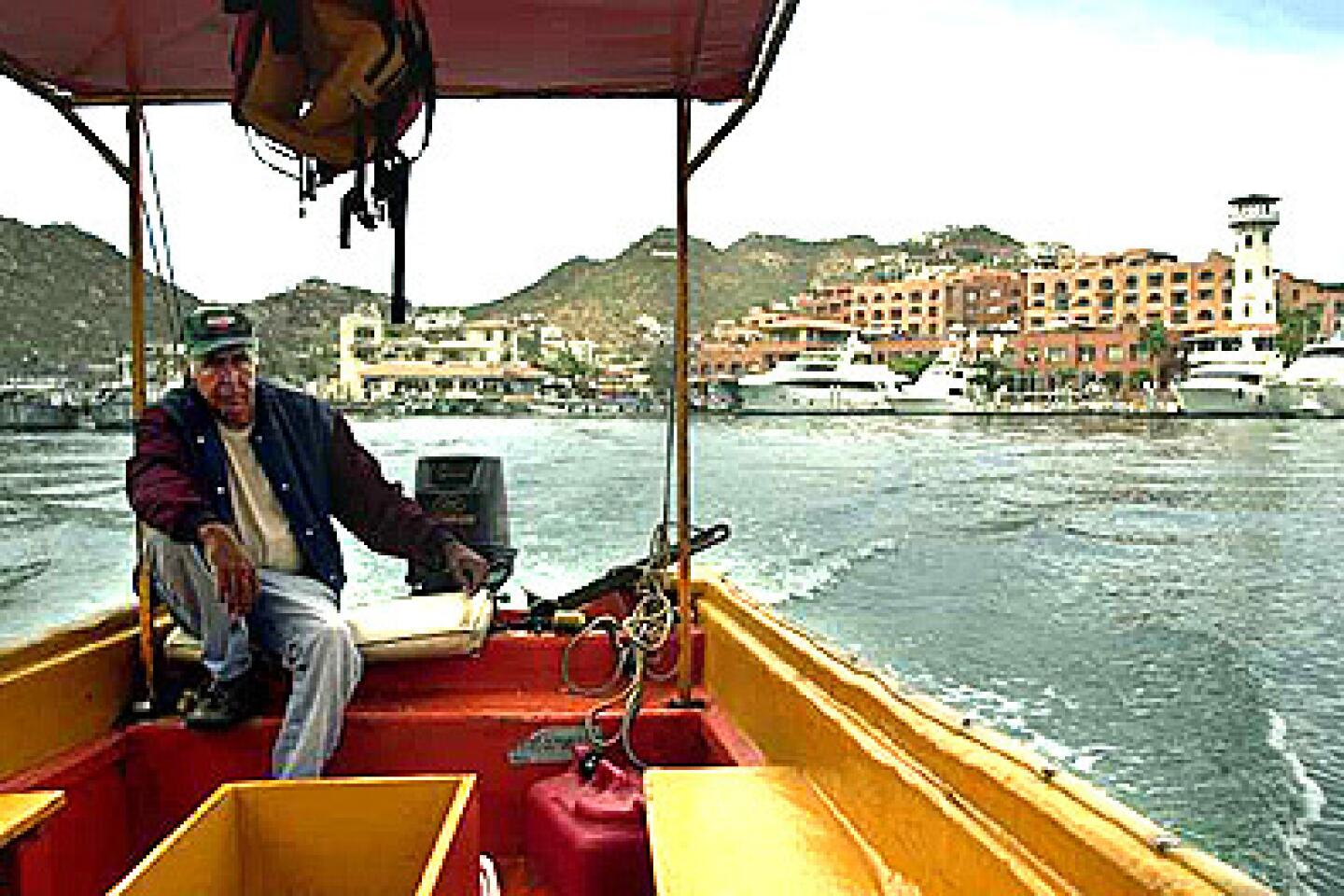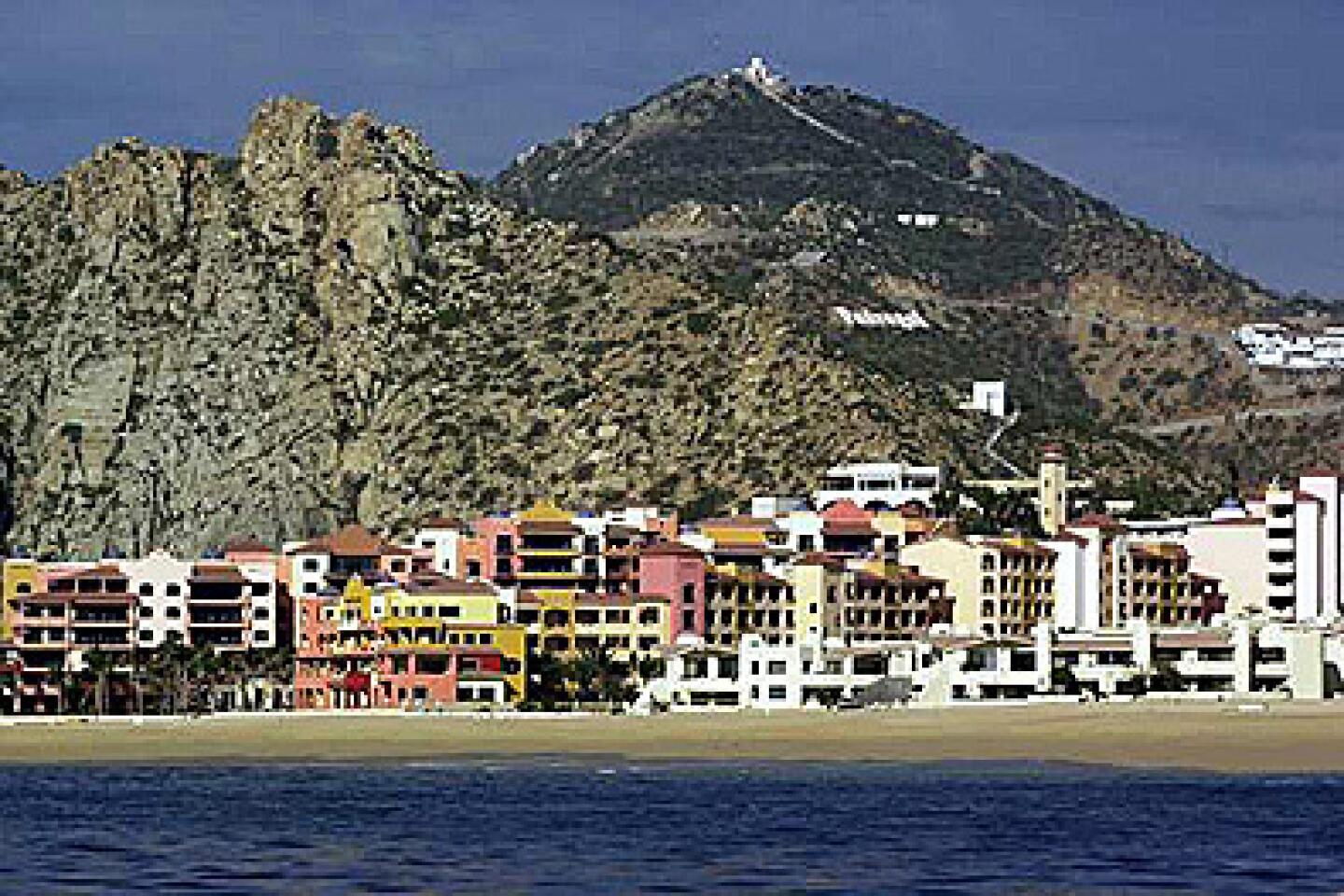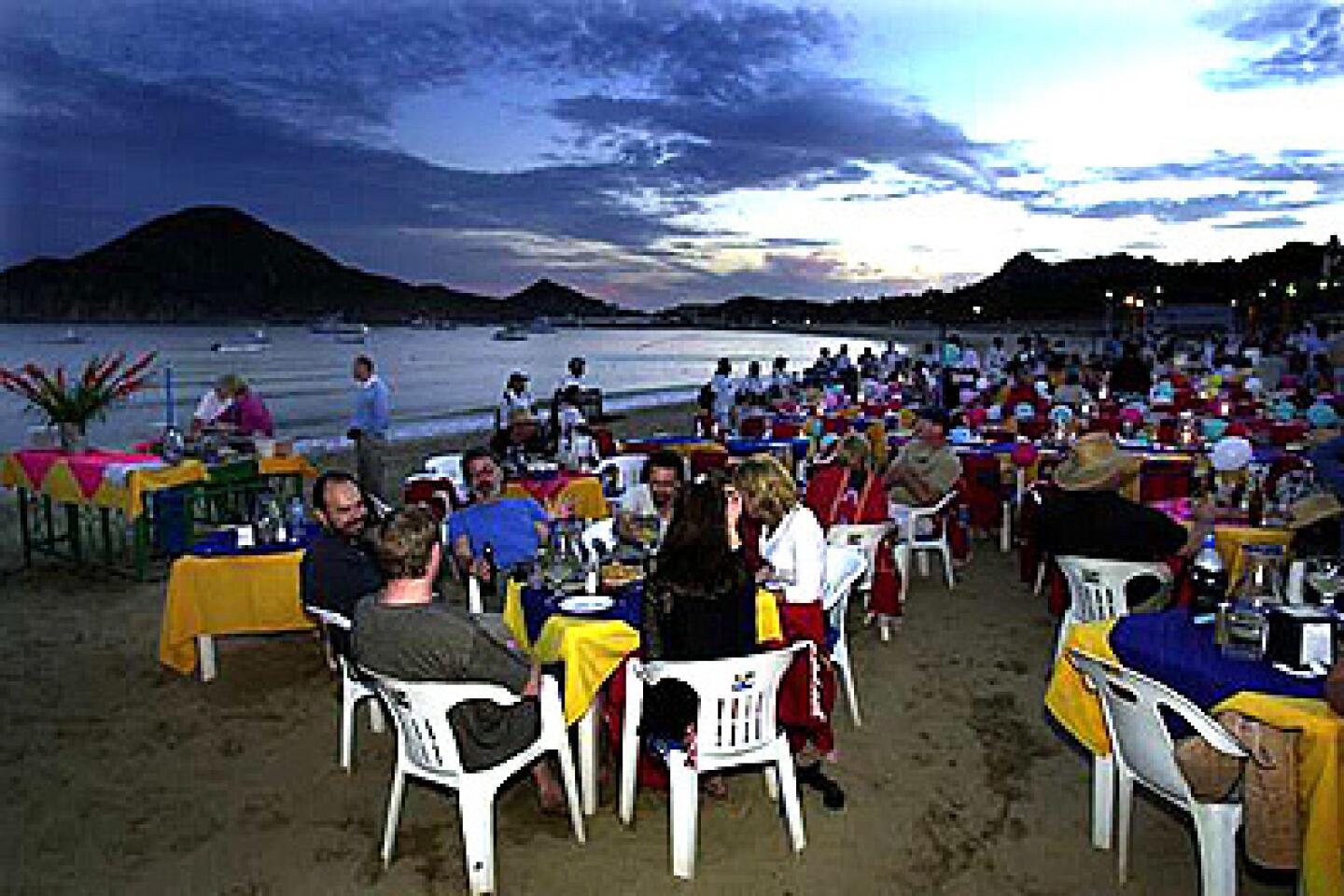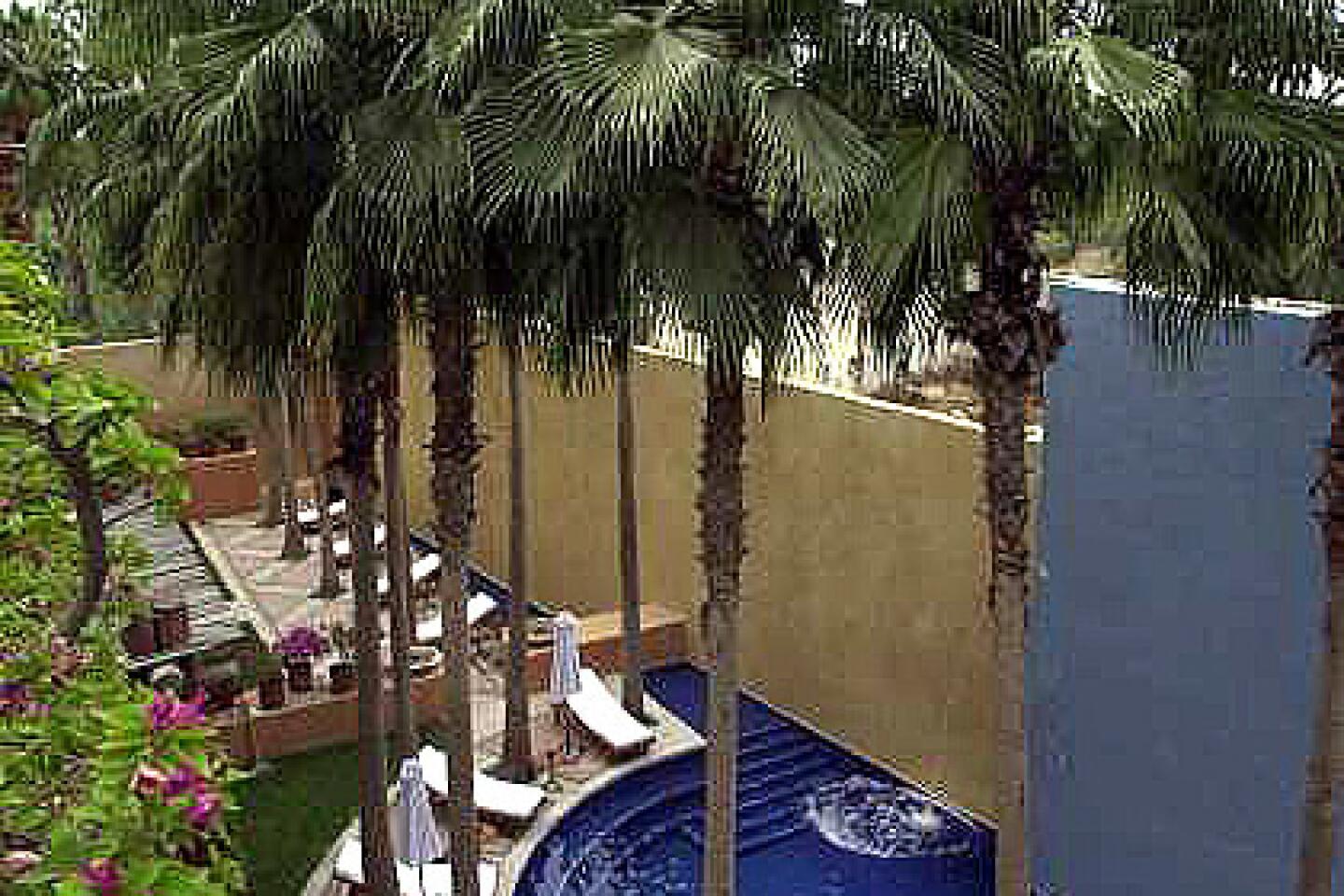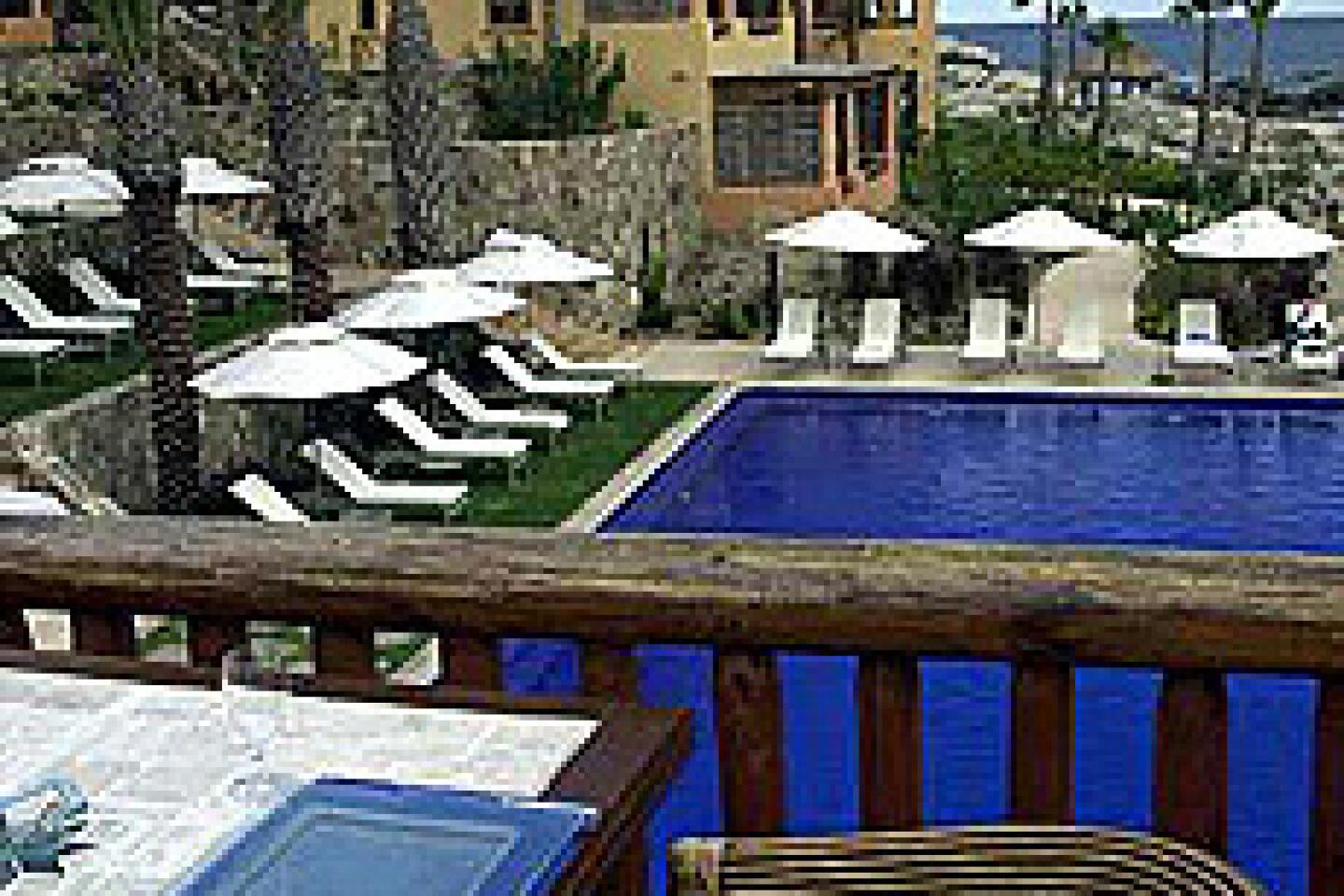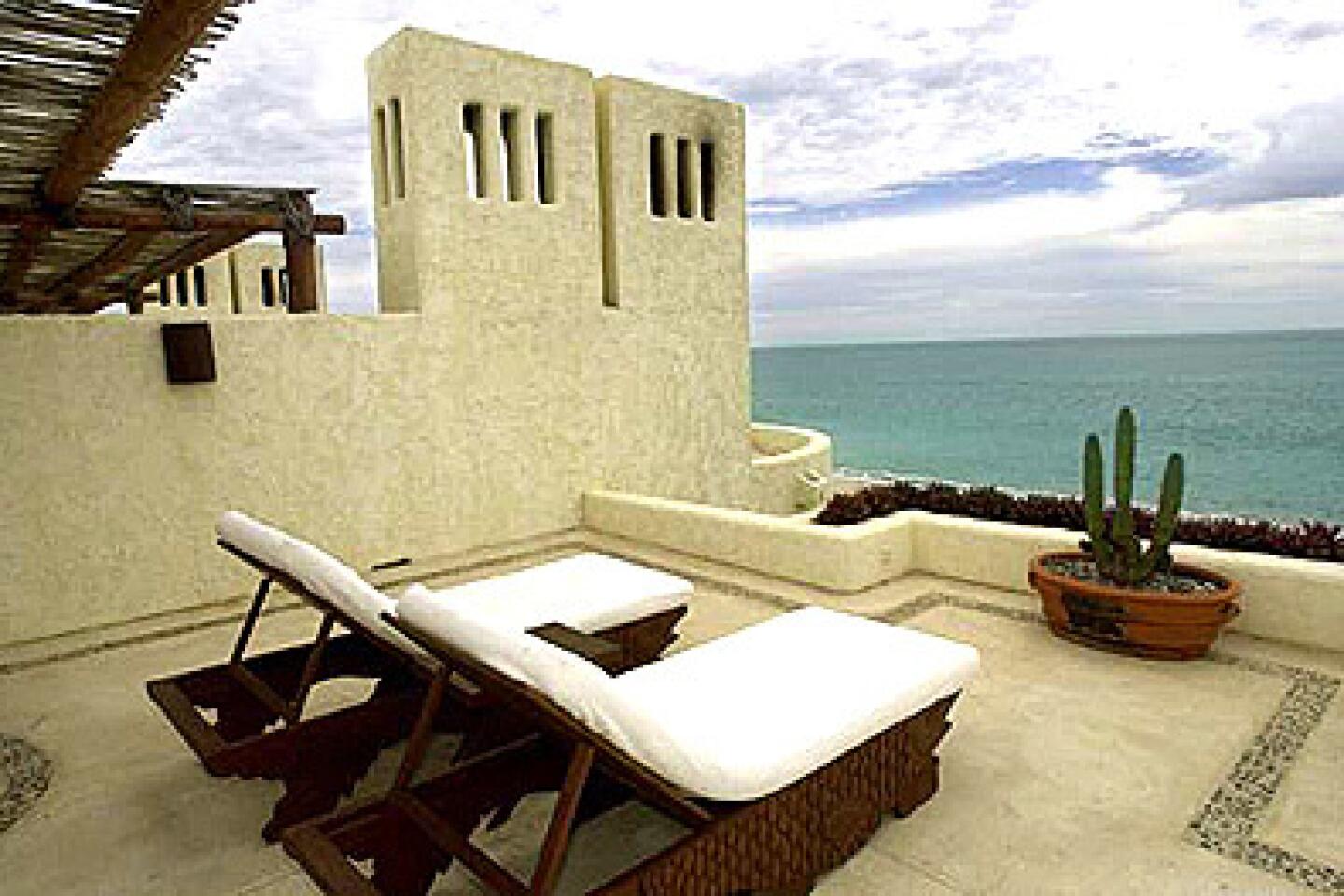The Cancuning of Cabo
Here at land’s end -- where, they say, the sun shines 350 days a year -- gallons of margaritas are poured, migrating whales spout in the Gulf of California, and bronzed and buff tourists lounge poolside at hotels that (for a price) offer every imaginable amenity, from massages under the stars to customized minibars.
But there are clouds on this sunny horizon.
Tourism is suffering. One hears it from the merchants in town, senses it by the empty restaurant tables. Some worry that Cabo San Lucas may be driving away tourists by offering too little for too much.
“People are trying to dress this place up like a ballroom queen and take her out dancing before she’s learned to walk,” says David Halliburton Jr., whose late father, David Sr., opened the Twin Dolphin in 1977. At the time it was one of a handful of resorts in Cabo and along the 20-mile oceanfront corridor between Cabo and San José del Cabo, together known as Los Cabos and dotted with luxury hotels. “They’re just jacking their prices up and pretending there’s nothing wrong.”
Before a recent trip to Los Cabos, I contacted Halliburton, who is pinch-hitting as general manager of Twin Dolphin, and asked if he would show me around and introduce me to some longtime residents who could share the history of the area and discuss its growing pains.
I soon learned that environmentalists, concerned about depletion of game fish in what has been dubbed “God’s fish tank,” recently won a battle to restrict commercial fishing to 50 miles offshore. There is organized opposition from a group calling itself Defenders of the Bay to a proposal to build a dock at Cabo San Lucas marina so big that cruise ships, which now must anchor offshore, can come into the harbor to disgorge passengers. (More than 400,000 cruise takers were aboard ships calling last year at Cabo.)
Los Cabos makes a point of wanting to be Mexican, not Miami Beach or Waikiki, yet it is teetering perilously close to both. Wrapped in the arms of a $400-a-day hotel, you can easily forget that you’re in Mexico -- and the desert at that.
The area’s first hotel, the Palmilla, was built in 1956 on the corridor. Guests came by yacht or private plane, landing on a rudimentary airstrip. Where today four-lane Highway 1 takes visitors from Cabo San Lucas to San José del Cabo, in the ‘60s there was only a dirt road hugging this coast; the journey took four hours, dodging a cow or two.
The opening of the 1,000-mile transpeninsular highway from California to Cabo in 1973 brought the first wave of tourists, many in RVs. The tsunami came after the 1977 opening of the international airport near San José.
Today there are 8,200 hotel rooms, with 9,100 projected for next year -- up from 5,731 only five years ago. In-season rates at one boutique hotel begin at $250, and rates run as high as $5,000 a night for a three-bedroom suite.
Westin is here, as are Auberge and Rosewood. A Ritz-Carlton stands as a great gray hulk, abandoned when economic turmoil hit Mexico several years ago. As many golfers as fishermen now visit, lured by nine courses, including the oceanfront Jack Nicklaus-designed Cabo del Sol, where prime-time greens fees are $262. Increasingly, visitors come not to golf or fish but to be pampered at luxe spas.
To “old-timers” -- and that includes those who have lived here for 20 years -- there’s something of a through-the-looking-glass quality to this. At Minerva’s Bait and Tackle in Cabo, ex-Angeleno Bob Smith, who settled here with his wife, Minerva, in 1978, recalls, “This was just a small village. Everybody knew what time it was because they blew the whistle at the [now-defunct tuna] cannery. That was the only industry.
“We didn’t make any money, but it was a fabulous community. Everybody was here to help everybody. You don’t have that anymore.”
Smith, who operates three charter boats, is among those fighting to restrict commercial fishing. “This used to be a great swordfish area. Now you’re lucky if you ever see one.”
Baja humbugs?
Time shares have become almost synonymous with Los Cabos. Having dodged the airport hawkers who pounce on arriving passengers, I felt victorious -- until at the Avis office my car keys came with a time-share pitch (car discount and free breakfast). “Time scares,” some here call them, and the hard sell abounds.
In town, salesmen pop out of booths. At one, Javier offered us a discount on a booze cruise aboard a pretend pirate ship with mariachis and “all you can drink.”
Even at the newish Pueblo Bonito Sunset Beach Hotel, about 10 minutes west of central Cabo San Lucas, where the small lobby is dominated by a gilded and silvered carving of an archangel and a painting of cherubs and saints in the manner of colonial Mexico, the desk clerk is pitching the hotel’s time shares. (In Los Cabos, time shares piggyback at most hotels.)
At Pisces Real Estate in town, Marco Ehrenberg talks about “the time-share craziness,” which took off in the late ‘80s. “Cabo is one of the most successful time-share places in the world,” says Ehrenberg, also a founding co-owner of El Squid Roe, a raucous and fabled nightspot that after 15 years still packs in the dance-on-the-tables-and-have-tequila-squirted-into-your-mouth-with-a-spray-gun crowd.
Juan Zamora, president of the Timeshare Assn. of Los Cabos, says that four of the area’s 18 time-share resorts are sold out and the other 14 account for “around $140 million” in sales annually, at an average price of $16,000 a week. Time-share sales fell about 25% after Sept. 11, Zamora says, and “now, with the concern about the war, we’re also suffering a little bit.”
Ehrenberg’s wife, Tracy, a transplanted Brit, runs the other family business, Pisces Sportfishing at the marina, booking luxury fishing charters for catch-and-release billfishing for up to $3,500 a day. When the Ehrenbergs arrived, Cabo’s population was 4,800. Today it’s about 100,000 in Los Cabos. “There were donkeys right along the main street, eating out of trash cans,” she says. strapped
Marco Ehrenberg, who is the chamber of commerce’s vice president for tourism, sees the stunning transformation of Cabo as a good thing for the locals but thinks the tourism industry may be overreaching.
“Where’s the service? Where’s the quality of the product?” he asks. “I think we’re going to get an adjustment. Even millionaires expect value for their money.”
In the February issue of Andrew Harper’s Hideaway Report, which caters to the high-end market, Cabo gets a scolding from readers, the editor reporting “lots of Baja humbugs for ‘outrageous,’ ‘unconscionable,’ ‘sky-high’ rates for food, drinks, golf and other amenities.”
Puerto Paraíso, a new trilevel mall at the marina, has 350,000 square feet and plans for 200 shops, but, save for the bowling alley and children’s play center and a multiplex cinema that opened in December, it’s a ghost town, with only a handful of retail occupants. Ruth’s Chris Steak House, Houlihan’s and Johnny Rockets are open. Two more hotels and an adjacent convention center are planned.
Patrick Sanchez, general manager of the Westin Regina on the corridor and vice president for marketing of Los Cabos Hotel Assn., is a self-described “cautious optimist” but acknowledges that the situation is “very challenging.” Last year Cabo room rates were slashed an average of 30%. “That’s the good news, because we are a very exclusive resort and a very expensive resort,” he says. But he is somewhat “alarmed” that group bookings have dropped from 2002 because of Sept. 11, the U.S. economy and uncertainty in the world. “There’s only so much demand for the destination. That could lead to additional discounting.”
A buyer’s market
Projections are for 800,000 visitors to Los Cabos this year. Still, hoteliers are promoting heavily, mindful of last year, when the number of hotel rooms grew at more than triple the rate of air passenger traffic, dropping overall occupancy rates to 50%. The goal now is not to dip below 50%.
Sanchez stops short of saying that Los Cabos is overbuilt but sees problems if supply continues to outpace demand. Mother Nature has imposed one control on the beachfront: a series of unbuildable arroyos that slice through the desert to the sea. The government hopes to impose another, requiring that new developments have facilities to reclaim water and to desalinate drinking water.
“I think we have learned from the rights and wrongs in other destinations -- Cancún, Acapulco, Mazatlán,” Sanchez says. There is talk of requiring new developments to help fund updating of Cabo’s infrastructure -- roads, lights, water and power. Many side streets in Cabo are unpaved, with potholes the size of sombreros.
The construction continues. Scheduled for an April 1 opening is the Marquis Cabo San Lucas, a 232-room corridor hotel with 40 swimming pools. The Pueblo Bonito chain plans to open a boutique luxury hotel in the Sunset Beach area, about 10 minutes west of Cabo, in 2004.
San José, once a snoozing 18th century mission town, is definitely waking up and now has more than two dozen hotels, upscale shops, restaurants and art galleries.
Some of Los Cabos’ attractions are natural -- lounging sea lions; whale watching from December to March; the picture-postcard landmark El Arco, carved through the rock where the Gulf of California meets the Pacific. Lovely beaches abound, although many have dangerous drop-offs and undertows.
The action is daylong at Playa el Médano right in Cabo -- kayaking, jet skiing, parasailing, then eating and drinking when the sun sets. The hot spot is the Office, where those at tables set on the beach between tiki torches are fair game for vendors hawking jewelry and serapes.
By day the town is quiet. Cruise ship passengers sip margaritas at open-air restaurants along the marina or peruse the shops, where salesmen stand outside. “You come off the ship?” they ask. There are the usual trinkets and T-shirts and seemingly enough silver jewelry to sink one of those ships.
At J&J Habanos, José Cantu sells Cuban cigars for up to $60 apiece. “The only people I sell to are Americans,” he says, adding, “not legally.” Business is “very bad.”
At the marina, Tony Miranda of Captain Tony’s -- “You hook ‘em, we cook ‘em” -- says, “The tourist business has been very hard for the last couple of years. It’s even worse now.” His wife, Deborah, a Californian, repeats an adage about the economy: “When the U.S. gets a cold, Mexico sneezes.”
When Tony came to Cabo in 1989, he says, it was a friendly, intimate place. “Now it’s very commercialized. Everybody just wants to sell.”
One thing they’re selling is property. It’s a buyer’s market for low-end condos ($50,000 to $200,000), older units with fewer amenities, says Ehrenberg. And, he adds, there is some “adjusting” at the high end. But oceanfront lots are fetching up to $2.5 million. “Beachfront is beachfront, here or in China. The boom is not over yet, but we’re getting more sophisticated buyers. People want value.”
“Value” is a word heard over and over. Most of the fancy hotels were built before Sept. 11, Halliburton of Twin Dolphin says. “People were paying way too much money for everything and charging too much money for everything.” Tourists have been “hammered,” he adds -- top prices, minimal hospitality -- and many have gone elsewhere. “This is the most expensive destination in Mexico, but the big money is leaving town.”
“If the tourists stop coming,” he muses, “they’ll probably have to fire that cannery up again.”
Sign up for The Wild
We’ll help you find the best places to hike, bike and run, as well as the perfect silent spots for meditation and yoga.
You may occasionally receive promotional content from the Los Angeles Times.


